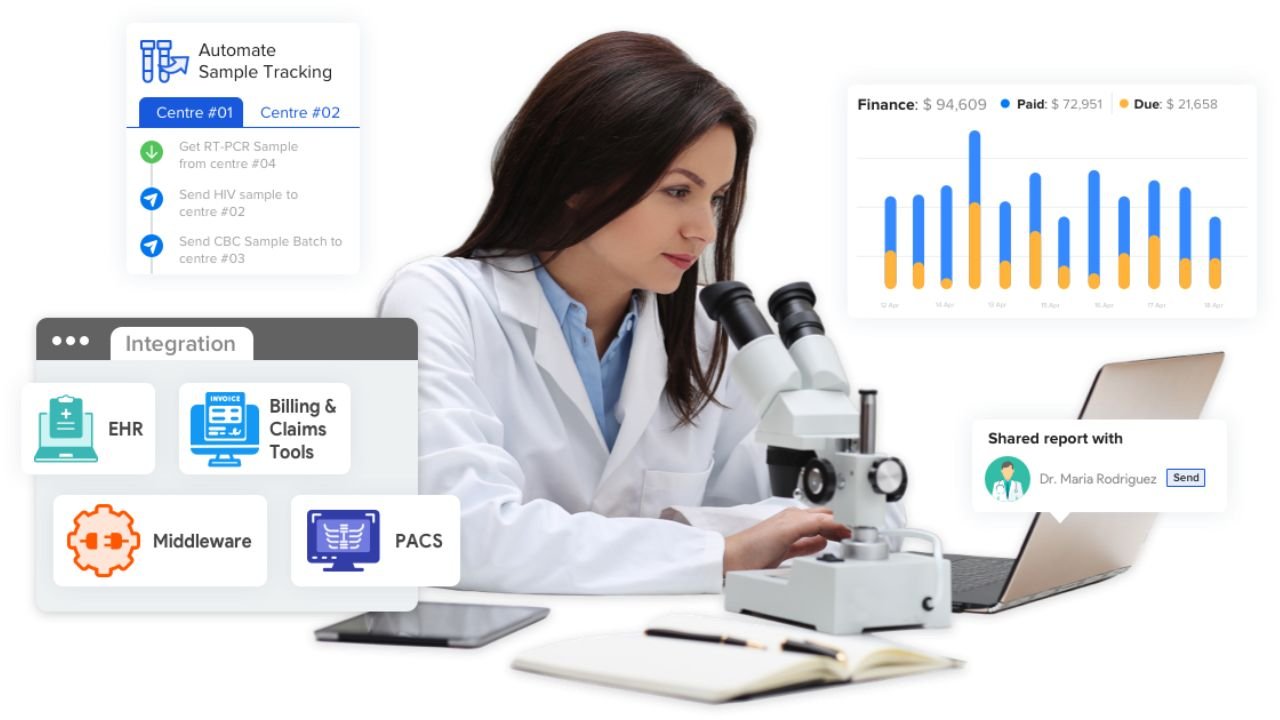In the world of healthcare, technology is making a big difference in how doctors and medical professionals work. One of the important tools that has changed the way laboratories function is pathology lab software. This kind of software is built to handle everything in a medical laboratory, from patient registration to test results and billing. It reduces manual work, saves time, and ensures that the chances of mistakes are very low.
Pathology labs are the backbone of medical diagnosis. They play a vital role in finding diseases, confirming medical conditions, and guiding doctors to choose the right treatment for patients. With the help of pathology lab software, these labs are now able to provide better services, maintain secure patient records, and deliver faster results.
What is a Pathology Lab?
A pathology laboratory is an establishment where tests are done on samples such as blood, urine or tissue. These examinations are performed in order to determine whether a patient is experiencing any health issues. Pathology labs are relevant, as the findings contained in the lab can assist the physician in determining the most appropriate treatment to give a patient.
There are small and large labs, the first of which conducts only the most common tests, such as blood sugar or cholesterol, and the second takes on complicated tests, such as genetic research or cancer diagnosis. These laboratories may be independent or a part of big hospitals and research centers. Without a laboratory of pathology, the contemporary health care system cannot operate successfully because doctors require test results to complement their clinical findings.
What is Pathology Lab Software?
Pathology lab software, also known as a pathology lab management system, is a digital solution that automates the work inside a laboratory. Instead of writing everything manually or storing data in registers, this software allows everything to be recorded, tracked, and managed on a computer or cloud-based system.
This software helps with patient registration, sample collection, report generation, billing, and even inventory management. It connects different parts of the lab so that work flows smoothly. For example, once a sample is collected, it is tracked through the system until the final report is ready. This makes the process faster and reduces the chance of losing or mixing samples.
Why Labs Need Pathology Management Systems
Accuracy is the primary reason why pathology labs should have digital management systems. Even a minor error in medical science can make a tremendous difference in how the patient is taken care of. Pathology lab software will make sure that data is processed right, the results are presented in time, and patients get the best services.
It also enhances efficiency since the duties that consumed hours of paperwork are done in minutes. To cite an example, the previous employees were required to type reports manually, whereas with the program, test results are automatically entered into professional report templates. This saves both doctors and patients valuable time as well.
Solutions Provided by Pathology Lab Software
Modern pathology lab software offers many solutions that simplify lab work. It ensures that all activities, from collecting samples to storing reports, happen in an organized way. Different modules in the software take care of patient records, test management, sample tracking, and inventory monitoring. This way, nothing is missed, and everything is properly documented.
Some software systems also connect directly with diagnostic machines. This means test results can be sent directly from the machine to the software without anyone entering them manually. Such features increase accuracy and speed in lab operations.
Key Features of Pathology Lab Software
A good pathology management system includes features like automated workflows, customizable reports, secure data storage, and real-time analytics. These features help labs run smoothly and improve the quality of services offered to patients.
For example, real-time dashboards show how many tests are pending, how many are completed, and how quickly results are being delivered. This helps lab managers make better decisions and maintain efficiency.
Benefits of Using Pathology Lab Software
Pathology lab software has a lot of advantages. It enhances the efficiency of tests, minimizes human error, and secures patient information. Treatment can commence in time since the doctors receive the result in a shorter time. The patients are also more satisfied as they do not spend much time waiting.
Labs also end up saving money since the software is a better place to manage resources. As an example, it can monitor chemicals and lab supplies to ensure that there are no shortages. It maintains test and financial records in detail as well, and thus it becomes simpler to track healthcare regulations.
Pathology Lab Software at a Glance
To understand the role of pathology lab software better, here is a table that summarizes its main areas of focus:
| Feature | Purpose |
| Patient Data Management | Keeps all patient records safe and easy to access |
| Sample Tracking | Follows each sample from collection to report |
| Report Generation | Creates quick and accurate test reports |
| Inventory Management | Monitors lab supplies and equipment |
| Integration | Connects with machines and hospital systems |
| Data Security | Protects sensitive patient information |
This table gives a clear picture of how the software covers almost every part of laboratory operations.
How to Implement Pathology Lab Software
Bringing pathology lab software into a laboratory requires planning. First, the lab must understand its own needs and decide what kind of system will work best. Small labs may need simple software, while larger labs may require advanced systems that handle multiple locations.
Once the software is chosen, the next step is to transfer existing records safely into the system. Staff must be trained to use the software properly so that daily operations continue smoothly. Regular updates and support from the software provider are also important to keep the system working without problems.
Challenges in Using Pathology Lab Software
Despite all the advantages, there are challenges that are experienced by some labs during the adoption of new technology. The first cost of purchasing and installing the software is one problem. The other obstacle is the training of the personnel since not all of them are conversant with digital systems initially.
Another significant issue is security of data. Labs deal with sensitive information about patients, and therefore, the software should be equipped with high-levels of resistance against cyber threats. Nevertheless, these difficulties can be overcome with the help of the appropriate provider and well-planned actions.
Pathology Lab Software: Moving Towards AI-Powered Precision
The future of the pathology lab software is very bright. With the ever-increasing growth in healthcare, it is only natural that the need to have quicker and more precise tests is going to rise. Most systems are being provided with Artificial Intelligence and Machine Learning, which enables the labs to estimate trends and identify patterns in medical data.
Another increasing trend is cloud-based software, according to which, a lab can access the data at any location and store substantial information safely. Over time, there will be a general transition to fully automated digital labs, as opposed to manual systems.
Conclusion
Pathology lab software is changing the way laboratories function in modern healthcare. It ensures accuracy, improves efficiency, and supports better patient care. From managing patient records and tracking samples to generating quick reports and monitoring inventory, it takes care of every important task inside a lab.
As more pathology labs adopt these systems, the overall quality of healthcare will improve. Doctors will get faster results, patients will receive better treatment, and labs will save time and resources. The shift from manual processes to digital systems is not just a trend but a necessary step for the future of medical diagnostics.
Read Our More Blogs:- How Are Lab Grown Diamonds Made? Process, Cost & Benefits



